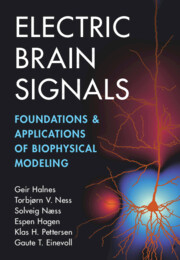Book contents
- Frontmatter
- Dedication
- Contents
- Preface
- Reserved Physical Symbols and Quantities
- Abbreviations
- 1 Introduction
- 2 Charges, Currents, Fields, and Potentials in the Brain
- 3 Neural Dynamics
- 4 Volume-Conductor Theory
- 5 Conductivity of Brain Tissue
- 6 Schemes for Computing Extracellular Potentials
- 7 Spikes
- 8 Local Field Potentials (LFPs)
- 9 Electroencephalography (EEG)
- 10 Electrocorticography (ECoG)
- 11 Magnetoencephalography (MEG)
- 12 Diffusion Potentials in Brain Tissue
- 13 Final Comments and Outlook
- Appendix A Frequency-Dependent Length Constant
- Appendix B Derivation of the Current-Dipole Approximation
- Appendix C Electric Stimulation
- Appendix D Derivation of the Point-Source Equation for Anisotropic Medium
- Appendix E Statistical Measures
- Appendix F Fourier-Based Analyses
- Appendix G Derivation of Formulas for Population Signals
- Appendix H Equations for Computing Magnetic Fields
- Appendix I Derivation of the MC+ED Scheme
- References
- Index
9 - Electroencephalography (EEG)
Published online by Cambridge University Press: 30 May 2024
- Frontmatter
- Dedication
- Contents
- Preface
- Reserved Physical Symbols and Quantities
- Abbreviations
- 1 Introduction
- 2 Charges, Currents, Fields, and Potentials in the Brain
- 3 Neural Dynamics
- 4 Volume-Conductor Theory
- 5 Conductivity of Brain Tissue
- 6 Schemes for Computing Extracellular Potentials
- 7 Spikes
- 8 Local Field Potentials (LFPs)
- 9 Electroencephalography (EEG)
- 10 Electrocorticography (ECoG)
- 11 Magnetoencephalography (MEG)
- 12 Diffusion Potentials in Brain Tissue
- 13 Final Comments and Outlook
- Appendix A Frequency-Dependent Length Constant
- Appendix B Derivation of the Current-Dipole Approximation
- Appendix C Electric Stimulation
- Appendix D Derivation of the Point-Source Equation for Anisotropic Medium
- Appendix E Statistical Measures
- Appendix F Fourier-Based Analyses
- Appendix G Derivation of Formulas for Population Signals
- Appendix H Equations for Computing Magnetic Fields
- Appendix I Derivation of the MC+ED Scheme
- References
- Index
Summary
The electroencephalographic (EEG) signal is the electric potential recorded on the scalp, and it is believed to originate from the combined activity of large populations of neurons. In forward models of EEG signals, one typically (i) represents neuronal sources in terms of effective current dipoles, (ii) defines a head model, which is a specification of the conductivity profile for the medium between the sources and the recording position (brain tissue, cerebrospinal fluid, skull, scalp), and (iii) uses volume-conductor theory to compute the resulting electric potential at the scalp. In this chapter, we introduce the key theory and computational frameworks for modeling EEG signals. We illustrate how biophysically detailed models of neurons can be reduced to approximate equivalent dipoles, and we discuss further ways to simplify neural simulations in order to reduce the computational cost. Using a combination of computational modeling and analytical approximations, we analyze how various factors are involved in shaping the EEG signal.
Keywords
- Type
- Chapter
- Information
- Electric Brain SignalsFoundations and Applications of Biophysical Modeling, pp. 241 - 269Publisher: Cambridge University PressPrint publication year: 2024

